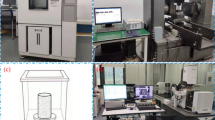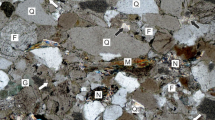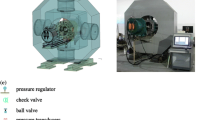Abstract
Across the globe, the formation of large oil and gas fields is always associated with a wide range of anhydrite cap rocks. Thus, an accurate analysis of the dynamic and static mechanical properties of anhydrite rocks is required. A deep thick anhydrite cap rock is developed in the Paleogene formation of the southwestern Tarim Basin, NW China. In this paper, we designed mechanical and acoustic synchronization tests and acquired the corresponding parameters. The effects of stress and mineral composition on the dynamic and static mechanical properties of the anhydrite rock were analyzed systematically. The results indicate that under uniaxial conditions, the anhydrite rock showed obvious brittle rupture characteristics, while under triaxial conditions, the shear rupture characteristics were obvious. The stress–strain curves of the anhydrite rocks under triaxial conditions can be divided into five stages: initial compression stage, linear elasticity stage, nonlinear steady extension stage, nonlinear unsteady extension and failure stage and post-peak stress stage. An increase in the anhydrite content can delay the weakening time of the anhydrite rocks, greatly improving the rock strength. Under high-stress conditions, the anhydrite mineral particles can accumulate large amounts of energy, exhibit a long period of creep behavior and produce significant additional stresses. The anhydrite composition can improve the strength and rigidity of the anhydrite rocks. However, anhydrite rock with a high anhydrite content will also have strong plasticity. The greater the stress environment that the anhydrite rock bears, the stronger its plasticity will be. The anhydrite component can improve the ability of the anhydrite rocks to resist shear rupture. Compared to the anhydrite mudrocks (AMR), argillaceous anhydrite rocks (AR) have higher VP, VS and VP/VS values. There is a very good positive correlation between VP/VS and the anhydrite content. A regression model of the longitudinal and shear wave time differences of the anhydrite rocks is obtained, which can be used for the prediction of the shear wave time difference. The dynamic Young’s modulus, Poisson’s ratio and shear modulus of the AR are higher than those of the AMR. The regression models of dynamic and static mechanical parameters of the anhydrite rocks are also obtained. These models will be valuable in the evaluation of mechanical characteristics for similar types of anhydrite rocks worldwide.












Similar content being viewed by others
Change history
19 February 2019
The original publication of the article does not indicate the second affiliation of the author Shuai Yin
References
Aschwanden L, Diamond LW, Adams A, Mazurek M (2017) Anhydrite—dissolution porosity in the Upper Muschelkalk Carbonate Aquifer, NE-Switzerland: implications for geothermal energy and geological storage of gas. Procedia Earth Planet Sci 17:897–900
Asef MR, Farrokhrouz M (2017) A semi-empirical relation between static and dynamic elastic modulus. J Petrol Sci Eng 157:359–363
Brandao NB, Roehl D, Silva FDA, Silva RR (2017) The impact of cement slurry aging creep on the construction process of oil wells. J Petrol Sci Eng 157:422–429
Deng JG, Tan Q, Shen C, Wei BH, Sun Y, Xu XG (2010) Research on the creeping of deep salt-gypsum rock in eastern Sichuan. Drill Prod Technol 33(4):8–9 (in Chinese with English abstract)
Eberhardt E (2012) The Hoek-Brown failure criterion. Rock Mech Rock Eng 45:981–988
Erarslan N, Williams DJ (2012) Experimental, numerical and analytical studies on tensile strength of rocks. Int J Rock Mech Min Sci 49:21–30
Fan XY, Gong M, Zhang QZ, Wang JR, Bai L, Chen YJ (2014) Prediction of the horizontal stress of the tight sandstone formation in eastern Sulige of China. J Petrol Sci Eng 113:72–80
Freyer D, Voigt W (2003) Invited review, crystallization and phase stability of CaSO4 and CaSO4-based salts. Monatsh Chem 134:693–719
George M, Olakunle OK, Emil JS, Abrahamson P (2017) Seismic interpretation and characterization of anhydrite caprocks in the Troms Basin, SW Batents Sea. Mar Geol 390:36–50
Gurocak Z, Solanki P, Alemdag S, Zaman MM (2012) New considerations for empirical estimation of tensile strength of rocks. Eng Geol 45–146:1–8
Hangx S, Spiers C, Peach C et al (2009) The mechanical behavior of anhydrite and the effect of CO2 injection. Energy Procedia 1:3485–3492
Hoek E, Marinos PG, Marinos VP (2005) Characterisation and engineering properties of tectonically undisturbed but lithologically varied sedimentary rock masses. Rock Mech Min Sci 42:277–285
Jin ZJ, Long SX, Zhou Y, Wo YJ, Xiao KH, Yang ZQ, Yin JY (2006) A study on the distribution of saline-deposit in southern China. Oil Gas Geol 27(5):571–583 (in Chinese with English abstract)
Jin ZJ, Zhou Y, Yun JB, Sun DS, Long SX (2010) Distribution of gypsum-salt rocks and near-term hydrocarbon exploration targets in the marine sequences of China. Oil Gas Geol 31(6):715–724 (in Chinese with English abstract)
Li DY, Wong LNY, Liu G, Zhang XP (2012) Influence of water content and anisotropy on the strength and deformability of low porosity meta-sedimentary rocks under triaxial compression. Eng Geol 126:46–66
Liang WG, Zhao YS, Xu SG, Dusseault MB (2011) Effect of strain rate on the mechanical properties of salt rock. Int J Rock Mech Min Sci 48:161–167
Liu WG, Shan YM, Fu RH (2006) A study of the relationship between the volumetric strain and the ultrasonic S-wave velocities in dilatancy of rocks. J Chengdu Univ Technol (Sci Technol Ed) 33(4):360–364 (in Chinese with English abstract)
Liu YM, Yu HM, Wang C, Wang CL (2011) Research on mechanism of damage of anhydrock in dolomite layer to tunnel structure. Rock Soil Mech 32(9):2704–2708 (in Chinese with English abstract)
Mahnken R, Kohlmeier M (2001) Finite element simulation for rock salt with dilatancy boundary coupled to fluid permeation. Comput Methods Appl Mech Eng 190:4259–4278
Mavko G, Mukerji T, Dvorkin J (1998) The rock physics handbook: tools for seismic analysis in porous media. Cambridge University Press, London
Moos D, Zoback MD (1990) Utilization of observation of well bore failure to constrain the orientation and magnitude of crustal stresses: application to continental, deep sea drilling project, and ocean drilling program boreholes. J Geophys Res 95:9305–9325
Naumann M, Hunsche U, Schulze O (2007) Experimental investigation on anisotropy in dilatancy, failure and creep of Opalinus clay. Phys Chem Earth 32:889–895
Nelson EJ, Meyer JJ, Hillis RR, Mildren SD (2005) Transverse drilling-induced tensile fractures in the West Tuna area, Gippsland basin, Australia: implications for the in situ stress regime. Int J Rock Mech Min Sci 42:361–371
Reisabadi MRZ, Kaffash A, Shadizadeh SR (2012) Determination of optimal well trajectory during drilling and production based on borehole stability. Int J Rock Mech Min Sci 56:77–87
Ren YK, Gao LY, Wang WL (1996) SY/T 5336-1996, method of core routine analysis. Petroleum Industry Press, Beijing
Ren Y, Li TB, Zhang GY, Niu WL, Lin ZH (2011) Research and application of BQ-hg method for surrounding rock classification of tunnels with high geostress. Chin J Underground Space Eng 7(3):449–455 (in Chinese with English abstract)
Rodriguez EAP, Guillon E, Houvenaghel G, Colombani J (2014) Wet creep of hardened hydraulic cements—example of gypsum plaster and implication for hydrated Portland cement. Cem Concr Res 63:67–74
Valdiviezo-Mijangos O, Nicolás-López R (2014) Dynamic characterization of shale systems by dispersion and attenuation of P-and S-waves considering their mineral composition and rock maturity. J Pet Sci Eng 122:420–427
Xu J, Li SC, Tao YQ, Tang XJ, Wu X (2009) Acoustic emission characteristic during rock fatigue damage and failure. Proc Earth Planet Sci 1:556–559
Yang SQ, Jing HW, Cheng L (2014) Influences of pore pressure on short-term and creep mechanical behavior of red sandstone. Eng Geol 179(4):10–23
Yin S, Zhou W, Shan YM, Ding WL, Xie RC, Guo CH (2017) Assessment of the stress field of deep-thick gypsum cap rocks: a case study of Paleogene Formation in the southwestern Tarim Basin, NW China. J Petrol Sci Eng 154:76–90
Yu LJ, Zhang WT, Fan M (2012a) Study of gypsum rock triaxial compression experiment and characteristic of high temperature phase transition. Rock Soil Mech 33(11):3318–3322 (in Chinese with English abstract)
Yu WJ, Feng T, Wang WJ, Li SL (2012b) Coordination support systems in mining with filling and mechanical behavior. Chin J Rock Mech Eng 31(1):2803–2812 (in Chinese with English abstract)
Zeng YJ, Yang CH, Chen FDXL (2002) Numerical analysis of creep pressing stress of casing in deep salt rock stratum. Chin J Rock Mech Eng 21(4):595–598 (in Chinese with English abstract)
Zhang YZ, Chu ZH, Li M, Luo M (2001) An experimental study of acoustic dispersion of rock and extrapolation of the velocity. Chin J Geophys 44(1):103–111 (in Chinese with English abstract)
Zhang JC, James L, William S (2009) Stress, porosity, and failure-dependent compressional and shear velocity ratio and its application to wellbore stability. J Petrol Sci Eng 69:193–202
Zhou W, Yan CH, Wang SZ (2007) Evaluation method and application of oil and gas play current in situ stress field. Geology Press, Beijing, pp 50–60 (in Chinese)
Zhou HW, Wang CP, Han BB, Duan ZQ (2011) A creep constitutive model for salt rock based on fractional derivatives. Int J Rock Mech Min Sci 48:116–121
Zhuo QG, Li Y, Song Y et al (2013) Evolution of Paleogene saline deposits and effectiveness of traps in Kelasu tectonic zone, Kuqa Depression, Tarim Basin. Petrol Geol Exp 35(1):42–47
Zhuo QG, Zhao MJ, Li Y et al (2014) Dynamic sealing evolution and hydrocarbon accumulation of evaporite cap rocks: an example from Kuqa foreland basin thrust belt. Acta Petrol Sin 35(5):847–856
Zulauf G, Zulauf J, Bornemann O et al (2009) Experimental deformation of a single-layer anhydrite in halite matrix under bulk constriction. Part 1: geometric and kinematic aspects. J Struct Geol 31(4):460–474
Acknowledgements
This research was supported by the National Natural Science Foundation of China (Grant nos. 41572130, 41372139 and 41072098) and the National Science and Technology Major Project of China (2017ZX05035001-007 and 2016ZX05046-003-001). The authors would like to thank the staff of all of the laboratories that cooperated in performing the tests and analyses. We are also grateful to the anonymous reviewers, whose comments improved the quality of this manuscript.
Author information
Authors and Affiliations
Corresponding author
Rights and permissions
About this article
Cite this article
Yin, S., Xie, R. Experimental analysis of dynamic and static mechanical properties of deep thick anhydrite cap rocks under high-stress conditions. Carbonates Evaporites 34, 807–823 (2019). https://doi.org/10.1007/s13146-018-0450-1
Accepted:
Published:
Issue Date:
DOI: https://doi.org/10.1007/s13146-018-0450-1




